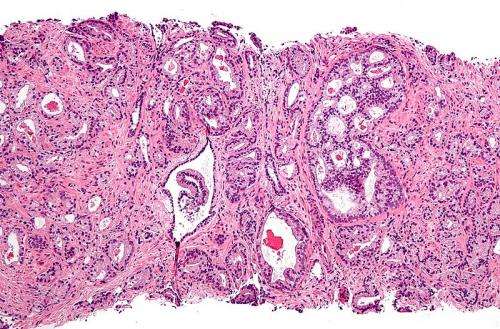博文
确定了调节前列腺癌缺氧的分子机制
 精选
精选
||
确定了调节前列腺癌缺氧的分子机制
诸平

Fig. 1 Micrograph showing prostatic acinar adenocarcinoma (the most common form of prostate cancer) Credit: Wikipedia, CC BY-SA 3.0
Fig. 2 Jindan Yu, MD, PhD, professor of Medicine in the Division of Hematology and Oncology and of Biochemistry and Molecular Genetics, was senior author of the study published in Oncogene.

Fig. 3 Lourdes Brea, a fourth-year student in the Driskill Graduate Program in Life Sciences (DGP), was co-first author of the study.
据美国西北大学(Northwestern University)梅丽莎 ·罗曼( Melissa Rohman)2022年9月2日报道,美国西北大学和中国上海交通大学医学院的研究人员合作,确定了一种有助于调节去势抵抗性前列腺癌进展的分子机制(Molecular mechanisms regulating prostate cancer hypoxia identified)。相关研究结果于2022年8月5日已经在《肿瘤基因》( Oncogene)杂志网站发表——Xiaohai Wang, Lourdes Brea, Xiaodong Lu, Galina Gritsina, Su H. Park, Wanqing Xie, Jonathan C. Zhao, Jindan Yu. FOXA1 inhibits hypoxia programs through transcriptional repression of HIF1A, Oncogene (2022). DOI: 10.1038/s41388-022-02423-6. Published: 05 August 2022. https://www.nature.com/articles/s41388-022-02423-6
参与此项研究的有来自美国西北大学范伯格医学院医学系血液学/肿瘤学部(Division of Hematology/Oncology, Department of Medicine, Northwestern University Feinberg School of Medicine, Chicago, IL, USA)、西北大学范伯格医学院罗伯特·卢里综合癌症中心(Robert H. Lurie Comprehensive Cancer Center, Northwestern University Feinberg School of Medicine, Chicago, IL, USA)、西北大学范伯格医学院生物化学与分子遗传学系(Department of Biochemistry and Molecular Genetics, Northwestern University Feinberg School of Medicine, Chicago, IL, USA)的研究人员,以及来自中国上海交通大学医学院附属上海总医院(Shanghai General Hospital, Shanghai Jiao Tong University School of Medicine, Shanghai, China)的研究人员。
由西北大学范伯格医学院医学系血液学与肿瘤学部和生物化学与分子遗传学系的医学教授于金丹博士( Jindan Yu, MD, PhD,Fig. 2)领导的研究人员发现,FOXA1蛋白的下调调节前列腺癌肿瘤中的缺氧(hypoxia)并促进肿瘤生长进展(tumor progression)。
“FOXA1在抑制谱系可塑性方面的功能很重要,因为使患者致死的是去势抵抗性前列腺癌的转移和耐药性,”于金丹说。
德里斯基尔生命科学研究生课程 ( DGP )的四年级学生卢尔德斯·布瑞亚(Lourdes Brea, Fig. 3)和上海交通大学医学院附属上海总医院的王晓海(Xiaohai Wang音译)是该研究的共同第一作者。
前列腺癌是美国男性癌症相关死亡率的第二大原因。虽然放射和激素治疗(hormone therapy)等治疗方案可有效治疗早期癌症,但许多患者会产生治疗抗性并进展为转移性去势抗性前列腺癌(castration-resistant prostate cancer简称CRPC)。
目前CRPC的治疗选择对患者的益处有限,很少有研究调查CRPC进展的缺氧分子机制,这对于开发有效的靶向治疗至关重要。
于金丹实验室等人最近的工作发现FOXA1在前列腺癌转移中下调,提示FOXA1可能在CRPC中发挥抑癌作用。
在目前的研究中,于金丹和合作者旨在确定FOXA1下调,是否控制前列腺肿瘤微环境中的缺氧编程并促进癌症进展。
通过对前列腺癌细胞系进行体外分析,研究人员发现FOXA1与HIF1A蛋白结合,抑制其表达。反过来,HIF1A有助于调节FOXA1缺失诱导的缺氧基因表达。
此外,通过 HIF1A,FOXA1下调促进巨噬细胞浸润到肿瘤微环境(tumor microenvironment)中,这有助于肿瘤变得免疫抑制并增加前列腺癌细胞的侵袭。
“当巨噬细胞被招募到肿瘤中时,它们实际上可以拮抗T细胞功能并削弱免疫反应( immune response),这是很糟糕的,”于金丹说。
研究结果表明FOXA1是调节CRPC中缺氧肿瘤微环境和整体促进前列腺癌进展的关键参与者。现在,于金丹的团队正在研究FOXA1在前列腺癌体内模型中调节免疫反应的作用。
“我们分别不同意业内人士提出的以FOXA1为治疗靶点的建议,因为它可能导致谱系可塑性、缺氧和CRPC进展。我们认为应该针对FOXA1缺失导致的上皮-间质转化(epithelial-mesenchymal transition)和缺氧程序来预防或治疗CRPC,”于金丹说。
这项工作得到了美国国立卫生研究院 (NIH) 的资助(NIH prostate SPORE P50CA180995;NIH R50CA211271;NIH/NCI training grant T32 CA009560)和前列腺癌基金会(Prostate Cancer Foundation)的部分支持(Prostate Cancer Foundation 2017CHAL2008)。
上述介绍,仅供参考。欲了解更多信息,敬请注意浏览原文或者相关报道。
Uncovering the function of prostate cancer protein
Intratumoral hypoxia is associated with castration-resistant prostate cancer (CRPC), a lethal disease. FOXA1 is an epithelial transcription factor that is down-regulated in CRPC. We have previously reported that FOXA1 loss induces epithelial-mesenchymal transition (EMT) and cell motility through elevated TGFβ signaling. However, whether FOXA1 directly regulates hypoxia pathways of CRPC tumors has not been previously studied. Here we report that FOXA1 down-regulation induces hypoxia transcriptional programs, and FOXA1 level is negatively correlated with hypoxia markers in clinical prostate cancer (PCa) samples. Mechanistically, FOXA1 directly binds to an intragenic enhancer of HIF1A to inhibit its expression, and HIF1A, in turn, is critical in mediating FOXA1 loss-induced hypoxia gene expression. Further, we identify CCL2, a chemokine ligand that modulates tumor microenvironment and promotes cancer progression, as a crucial target of the FOXA1-HIF1A axis. We found that FOXA1 loss leads to immunosuppressive macrophage infiltration and increased cell invasion, dependent on HIF1A expression. Critically, therapeutic targeting of HIF1A-CCL2 using pharmacological inhibitors abolishes FOXA1 loss-induced macrophage infiltration and PCa cell invasion. In summary, our study reveals an essential role of FOXA1 in controlling the hypoxic tumor microenvironment and establishes the HIF1A-CCL2 axis as one mechanism of FOXA1 loss-induced CRPC progression.
https://blog.sciencenet.cn/blog-212210-1354265.html
上一篇:量子猫的新皮毛:首次发现许多原子的纠缠
下一篇:自种秋葵
